Semantic Adaptive Communication Based on Double-Attention Phase and Compress Estimator for Wireless Image Transmission
Abstract
1. Introduction
1.1. Artificial Intelligent Wireless Transmission
1.2. Semantic Communication
1.3. The Challenges in SeC
1.4. The Contribution of Our Work
- (1)
- To enable flexible adaptation of Semantic Encoders and Decoders amid dynamic channel condition changes or across varying SNR values, this paper overcomes the key limitation of existing modules—most of which rely on fixed architectures tailored to a single SNR scenario. Specifically, we design an SAC framework comprising a lightweight Semantic Encoder (SE) and Decoder (SD), Semantic Code Generator (SCG), Semantic Content Restore (SCR) mechanism, and a Compression Estimator (CE), which generates flexibly adjustable semantic information to adaptive transmission.
- (2)
- To achieve the minimum CR value within a specific range of SNR for the CR adaptation, this paper designs a CR prediction module termed Compression Estimator (CE) via local decoding quality and channel conditions. This module reduces training complexity and time costs, as it only requires a single training process for intelligent recovery. Furthermore, by lever aging decoded image information, it also enhances the efficiency of image reconstruction tasks.
- (3)
- To enhance image reconstruction quality under constrained channel conditions, this paper designs an SE and SD module based on residual blocks, incorporating considerations of optimal feature selection and reconstruction accuracy. These components integrate a channel condition aware Double-Attention Module (DAM) so as to effectively strengthen the expressive capability of key semantic information and to improve module robustness, thus meeting the high demand for detail preservation and structural restoration in image reconstruction tasks. Furthermore, the proposed module achieves cross-data reconstruction generalization and can deliver high-quality image reconstruction results by adapting to diverse task requirements and dynamic channel conditions.
2. Proposed Semantic Adaptive Communication Framework
2.1. Semantic Encoder and Decoder
2.1.1. The Partial Window Block (PWB)
2.1.2. The Double-Attention Module (DAM) Based on Channel Condition
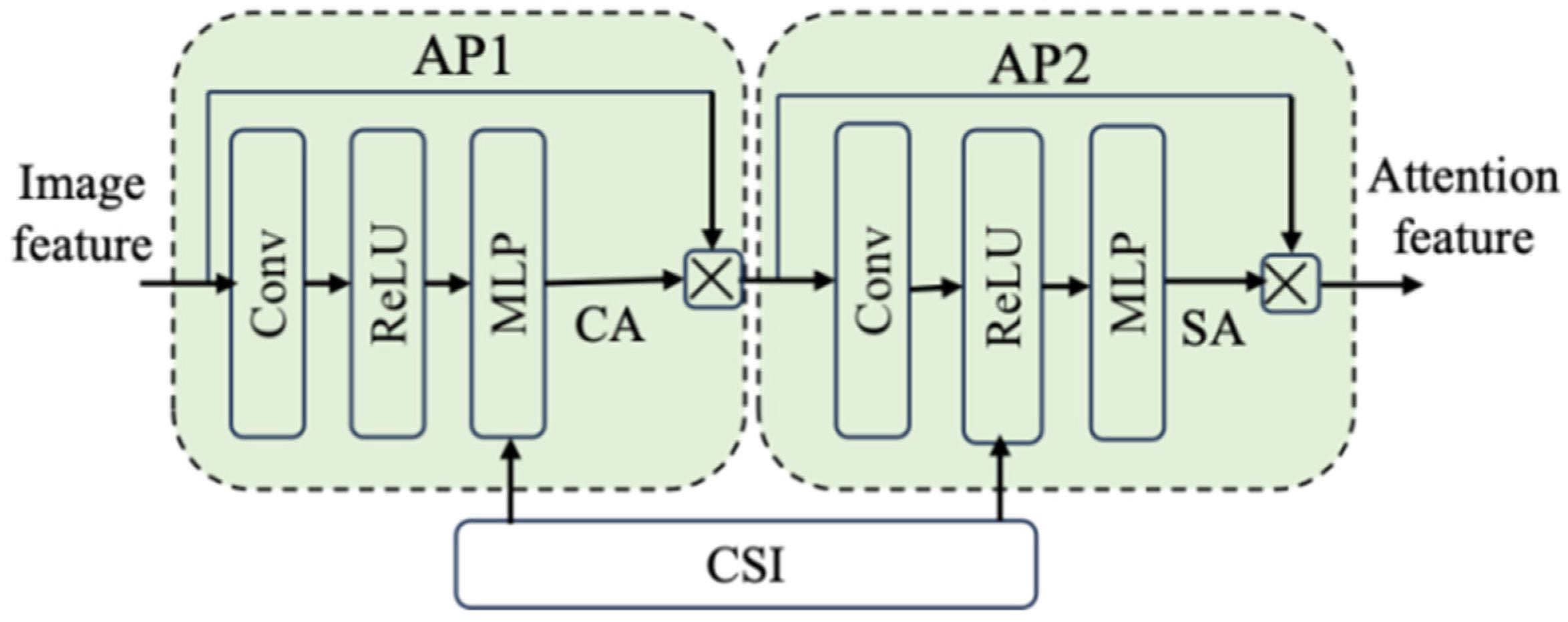

2.2. The Semantic Code Generator (SCG) and Semantic Content Restore (SCR)
2.3. Compression Estimator (CE)
3. The Training of the Proposed Framework
3.1. Model Optimization
3.2. Semantic Loss Function
4. Experiment
4.1. Experimentation Details
4.2. Datasets
4.3. Comparison with State-of-the-Art Methods
4.4. Ablation Study
4.4.1. Different Compression Ratios
4.4.2. Cross-Dataset Adaptive Reconstruction
4.4.3. Compression Estimator
4.4.4. Model Complexity
4.5. Visualized Analysis
5. Conclusions
Author Contributions
Funding
Data Availability Statement
Conflicts of Interest
References
- Zhang, Z.; Lung, C.H.; Wei, X.; Chen, M.; Chatterjee, S.; Zhang, Z. In-network caching for icn-based iot (icn-iot): A comprehensive survey. IEEE Internet Things J. 2023, 10, 14595–14620. [Google Scholar] [CrossRef]
- Kountouris, M.; Pappas, N. Semantics-Empowered Communication for Networked Intelligent Systems. IEEE Commun. Mag. 2021, 59, 96–102. [Google Scholar] [CrossRef]
- Xu, J.; Tung, T.Y.; Ai, B.; Chen, W.; Sun, Y.; Gündüz, D.D. Deep joint source-channel coding for semantic communications. IEEE Commun. Mag. 2023, 61, 42–48. [Google Scholar] [CrossRef]
- Yoo, H.; Dai, L.; Kim, S.; Chae, C.-B. On the role of ViT and CNN in semantic communications: Analysis and prototype validation. IEEE Access 2023, 11, 71528–71541. [Google Scholar] [CrossRef]
- Yang, Y.; Guo, J.; Ye, Q.; Xia, Y.; Yang, P.; Ullah, A.; Muhammade, K. A Weighted Multi-Feature Transfer Learning Framework for Intelligent Medical Decision Making. Appl. Soft Comput. 2021, 105, 107242. [Google Scholar] [CrossRef]
- Al-Quraan, M.; Mohjazi, L.; Bariah, L.; Centeno, A.; Zoha, A.; Arshad, K.; Assaleh, K.; Muhaidat, S.; Debbah, M.; Imran, M.A. Edge-native intelligence for 6G communications driven by federated learning: A survey of trends and challenges. IEEE Trans. Emerg. Top. Comput. Intell. 2023, 7, 957–979. [Google Scholar] [CrossRef]
- Chen, M.; Challita, U.; Saad, W.; Yin, C.; Debbah, M. Artificial neural networks-based machine learning for wireless networks: A tutorial. IEEE Commun. Surv. Tutor. 2019, 21, 3039–3071. [Google Scholar] [CrossRef]
- Zhang, C.; Patras, P.; Haddadi, H. Deep learning in mobile and wireless networking: A survey. IEEE Commun. Surv. Tutor. 2019, 21, 2224–2287. [Google Scholar] [CrossRef]
- Zhang, P.; Xu, X.; Dong, C.; Han, S.; Wang, B. Intellicise communication system: Model-driven semantic communications. J. China Univ. Posts Telecommun. 2022, 29, 2–12. [Google Scholar]
- Fu, Y.; Cheng, W.; Zhang, W. Content-aware semantic communication for goal-oriented wireless communications. In Proceedings of the IEEE INFOCOM 2023—IEEE Conference on Computer Communications Workshops (INFOCOM WKSHPS), New York, NY, USA, 17–20 May 2023; pp. 1–6. [Google Scholar]
- Huang, G.; An, J.; Yang, Z.; Gan, L.; Bennis, M.; Debbah, M. Stacked intelligent metasurfaces for task-oriented semantic communications. IEEE Wirel. Commun. Lett. 2024, 14, 310–314. [Google Scholar] [CrossRef]
- Yang, Y.; Hu, Y.; Zhang, X.; Wang, S. Two-Stage Selective Ensemble of CNN via Deep Tree Training for Medical Image Classification. IEEE Trans. Cybern. 2021, 52, 9194–9207. [Google Scholar] [CrossRef]
- Pan, Q.; Tong, H.; Lv, J.; Luo, T.; Zhang, Z.; Yin, C.; Li, J. Image segmentation semantic communication over internet of vehicles. In Proceedings of the 2023 IEEE Wireless Communications and Networking Conference (WCNC), Glasgow, UK, 26–29 March 2023; pp. 1–6. [Google Scholar]
- Zhang, H.; Wang, H.; Li, Y.; Long, K.; Nallanathan, A. DRL-Driven Dynamic Resource Allocation for Task-Oriented Semantic Communication. IEEE Trans. Commun. 2023, 71, 3992–4004. [Google Scholar] [CrossRef]
- Lan, Q.; Wen, D.; Zhang, Z.; Zeng, Q.; Chen, X.; Popovski, P.; Huang, K. What is semantic communication? A view on conveying meaning in the era of machine intelligence. J. Commun. Inf. Netw. 2021, 6, 336–371. [Google Scholar] [CrossRef]
- Luo, X.; Chen, H.-H.; Guo, Q. Semantic communications: Overview, open issues, and future research directions. IEEE Wirel. Commun. 2022, 29, 210–219. [Google Scholar] [CrossRef]
- Yang, W.; Du, H.; Liew, Z.Q.; Lim, W.Y.B.; Xiong, Z.; Niyato, D.; Chi, X.; Shen, X.S.; Miao, C. Semantic communications for future Internet: Fundamentals, applications, and challenges. IEEE Commun. Surv. Tutor. 2023, 25, 213–250. [Google Scholar] [CrossRef]
- Zhang, W.; Zhang, H.; Ma, H.; Shao, H.; Wang, N.; Leung, V.C.M. Predictive and adaptive deep coding for wireless image transmission in semantic communication. IEEE Trans. Wirel. Commun. 2023, 22, 5486–5501. [Google Scholar] [CrossRef]
- Zhang, P.; Xu, W.; Gao, H.; Niu, K.; Xu, X.; Qin, X.; Yuan, C.; Qin, Z.; Zhao, H.; Wei, J.; et al. Toward wisdom-evolutionary and primitiveconcise 6G: A new paradigm of semantic communication networks. Engineering 2022, 8, 60–73. [Google Scholar] [CrossRef]
- Trevlakis, S.E.; Pappas, N.; Boulogeorgos, A.-A.A. Toward natively intelligent semantic communications and networking. IEEE Open J. Commun. Soc. 2024, 5, 1486–1503. [Google Scholar] [CrossRef]
- Lu, Z.; Li, R.; Lu, K.; Chen, X.; Hossain, E.; Zhao, Z.; Zhang, H. Semantics-empowered communications: A tutorial-cumsurvey. IEEE Commun. Surv. Tutor. 2024, 26, 41–79. [Google Scholar] [CrossRef]
- Lokumarambage, M.U.; Gowrisetty, V.S.S.; Rezaei, H.; Sivalingam, T.; Rajatheva, N.; Fernando, A. Wireless end-to-end image transmission system using semantic communications. IEEE Access 2023, 11, 37149–37163. [Google Scholar] [CrossRef]
- Hu, Q.; Zhang, G.; Qin, Z.; Cai, Y.; Yu, G.; Li, G.Y. Robust semantic communications against semantic noise. In Proceedings of the 2022 IEEE 96th Vehicular Technology Conference (VTC2022-Fall), Beijing, China, 26–29 September 2022; pp. 1–6. [Google Scholar]
- Yang, K.; Wang, S.; Dai, J.; Tan, K.; Niu, K.; Zhang, P. WITT: A wireless image transmission transformer for semantic communications. In Proceedings of the ICASSP 2023—2023 IEEE International Conference on Acoustics, Speech and Signal Processing (ICASSP), Rhodos, Greece, 4–10 June 2023; pp. 1–5. [Google Scholar]
- Xu, J.; Ai, B.; Chen, W.; Yang, A.; Sun, P.; Rodrigues, M. Wireless image transmission using deep source channel coding with attention modules. IEEE Trans. Circuits Syst. Video Technol. 2021, 32, 2315–2328. [Google Scholar] [CrossRef]
- Sayood, K.; Otu, H.H.; Demir, N. Joint source/channel coding for variable length codes. IEEE Trans. Commun. 2000, 48, 787–794. [Google Scholar] [CrossRef]
- Hu, J.; Shen, L.; Sun, G. Squeeze-and-excitation networks. In Proceedings of the IEEE/CVF Conference on Computer Vision and Pattern Recognition, Salt Lake City, UT, USA, 3–7 June 2018; pp. 7132–7141. [Google Scholar]
- Yang, M.; Kim, H.-S. Deep joint source-channel coding for wireless image transmission with adaptive rate control. In Proceedings of the IEEE International Conference on Acoustics, Speech, and Signal Processing (ICASSP), Barcelona, Spain, 4–8 May 2022; pp. 5193–5197. [Google Scholar]
- Yang, H.; Zhu, X.; Yang, J.; Li, J.; Qing, L.; He, X.; Wang, P. Scalable Semantic Adaptive Communication for Task Requirements in WSNs. Sensors 2025, 25, 2823. [Google Scholar] [CrossRef]
- Xu, J.; Ai, B.; Wang, N.; Chen, W. Deep joint source-channel coding for CSI feedback: An end-to-end approach. IEEE J. Sel. Areas Commun. 2023, 41, 260–273. [Google Scholar] [CrossRef]
- Liu, Z.; Lin, Y.; Cao, Y.; Hu, H.; Wei, Y.; Zhang, Z.; Lin, S.; Guo, B. Swin transformer: Hierarchical vision transformer using shifted windows. In Proceedings of the IEEE/CVF International Conference on Computer Vision, Montreal, BC, Canada, 11–17 October 2021; pp. 10012–10022. [Google Scholar]
- Guo, L.; Chen, W.; Sun, Y.; Ai, B.; Pappas, N.; Quek, T.Q.S. Diffusion-Driven Semantic Communication for Generative Models with Bandwidth Constraints. arXiv 2024, arXiv:2407.18468. [Google Scholar] [CrossRef]
- Yang, M.; Liu, B.; Wang, B.; Kim, H.-S. Diffusion-aided joint source channel coding for high realism wireless image transmission. arXiv 2024, arXiv:2404.17736. [Google Scholar] [CrossRef]
- Zhang, M.; Wu, H.; Zhu, G.; Jin, R.; Chen, X.; Gündüz, D. Semantics-Guided Diffusion for Deep Joint Source-Channel Coding in Wireless Image Transmission. arXiv 2025, arXiv:2501.01138. [Google Scholar] [CrossRef]

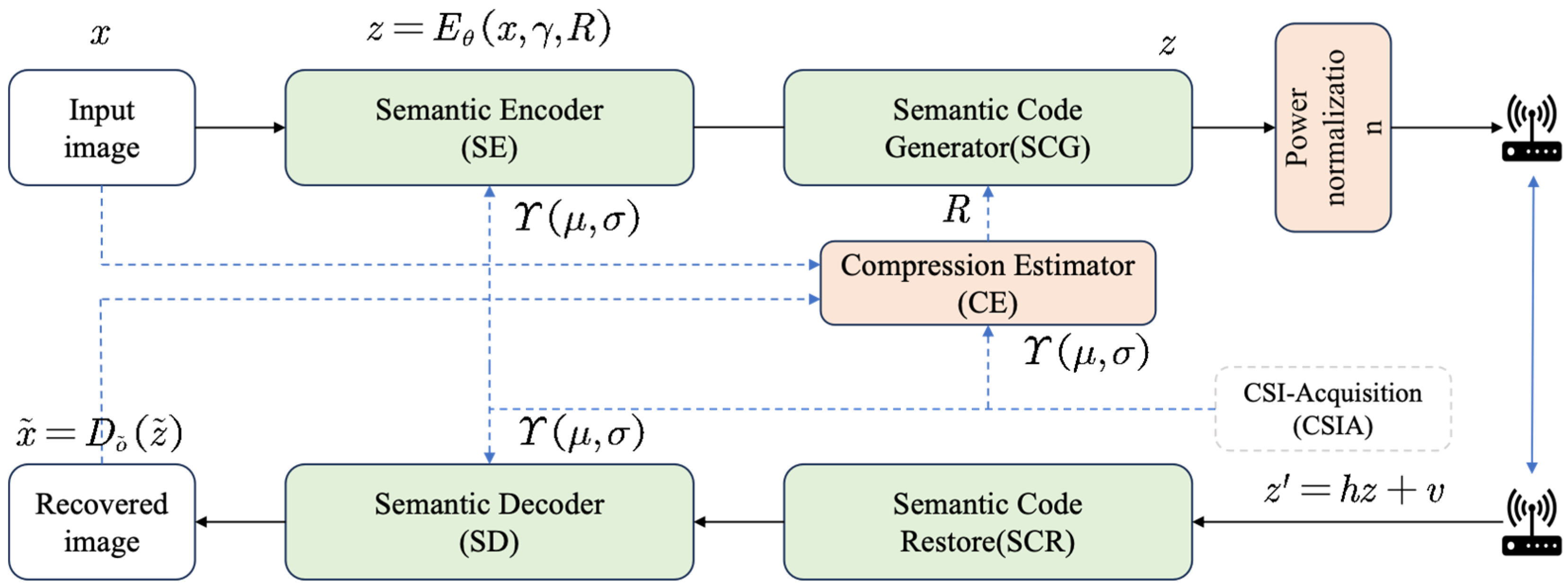
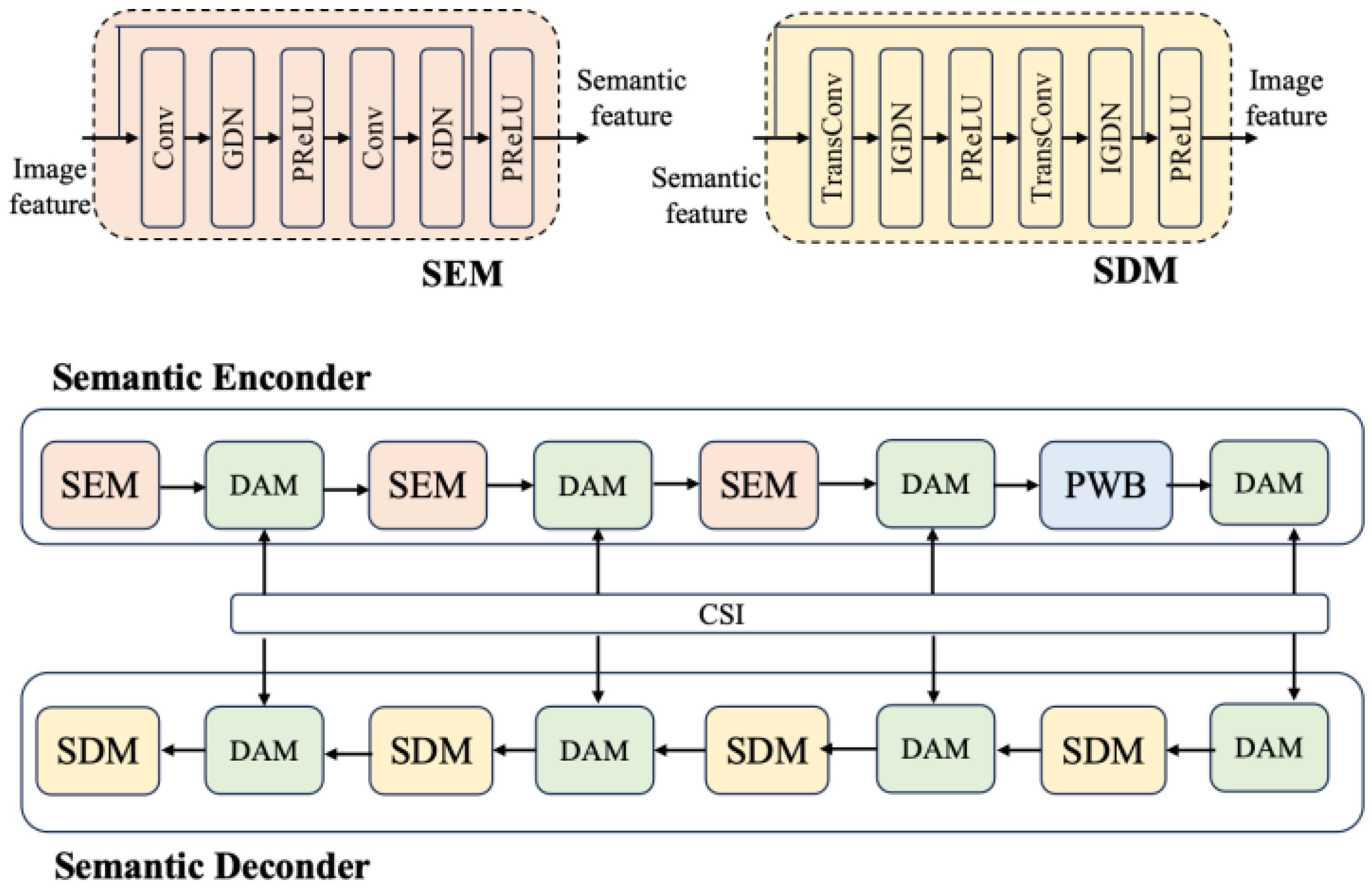


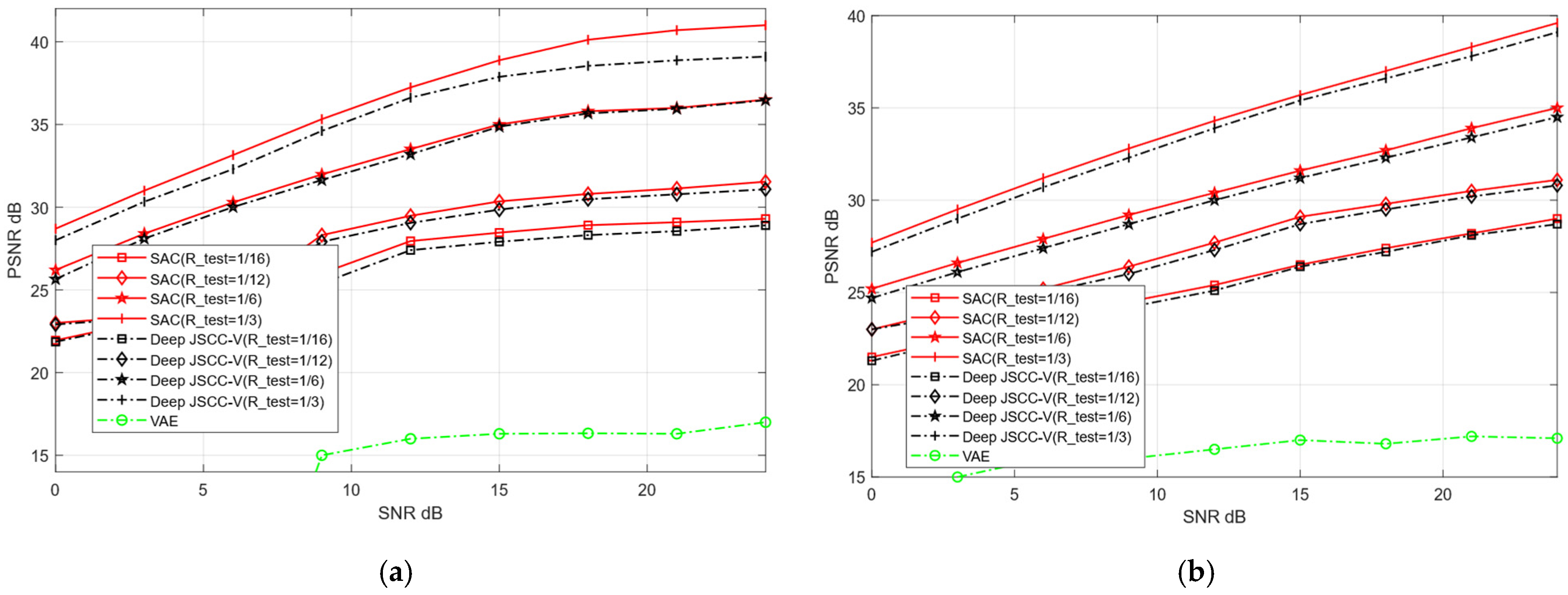
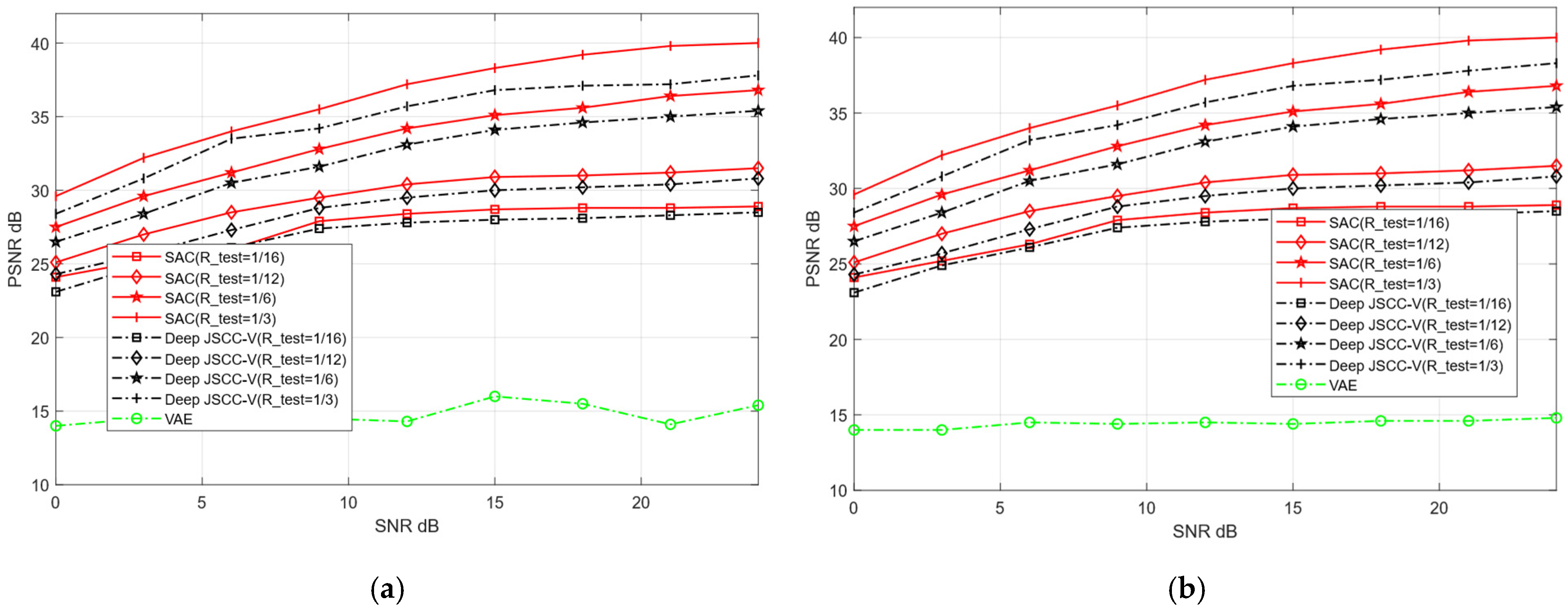



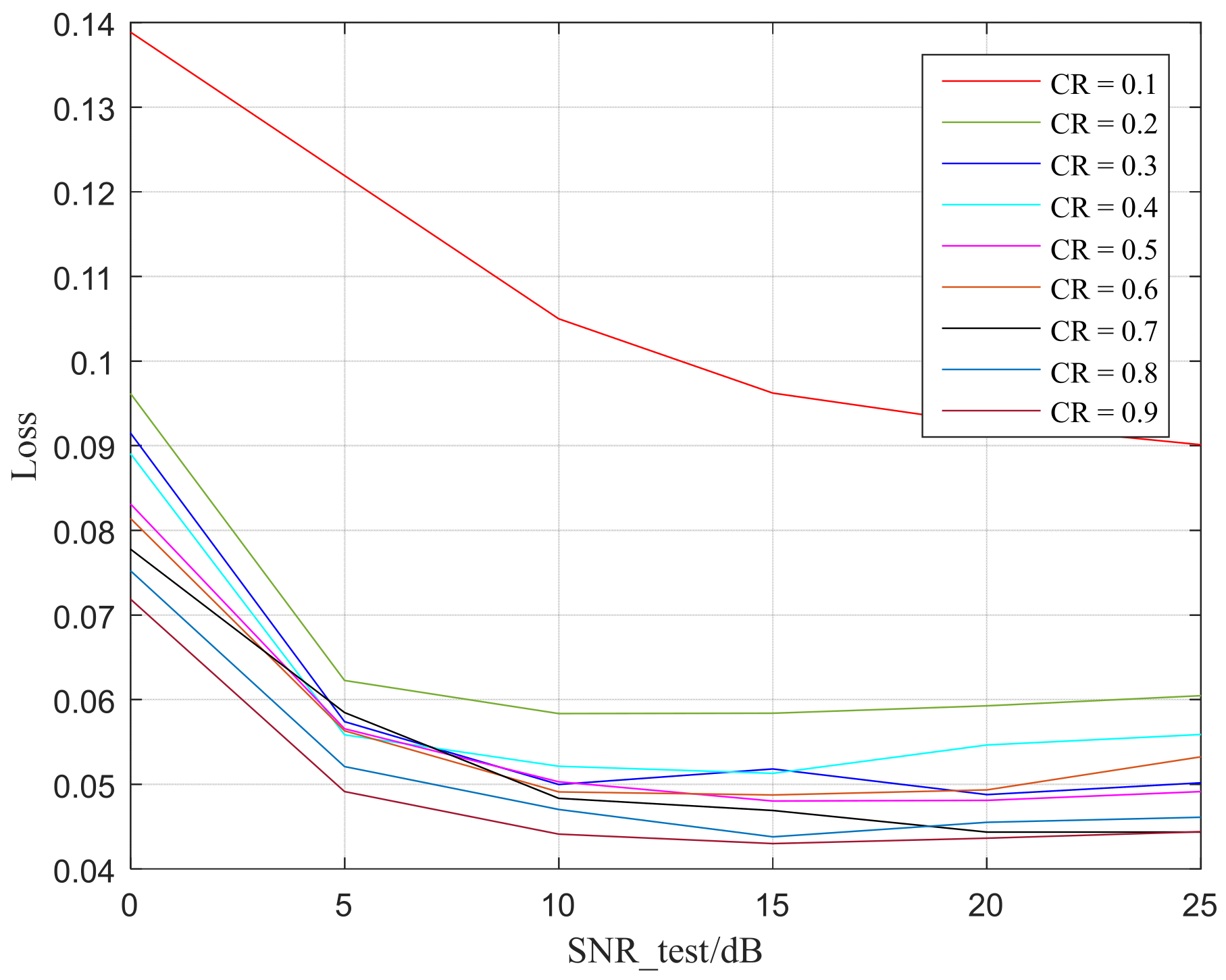

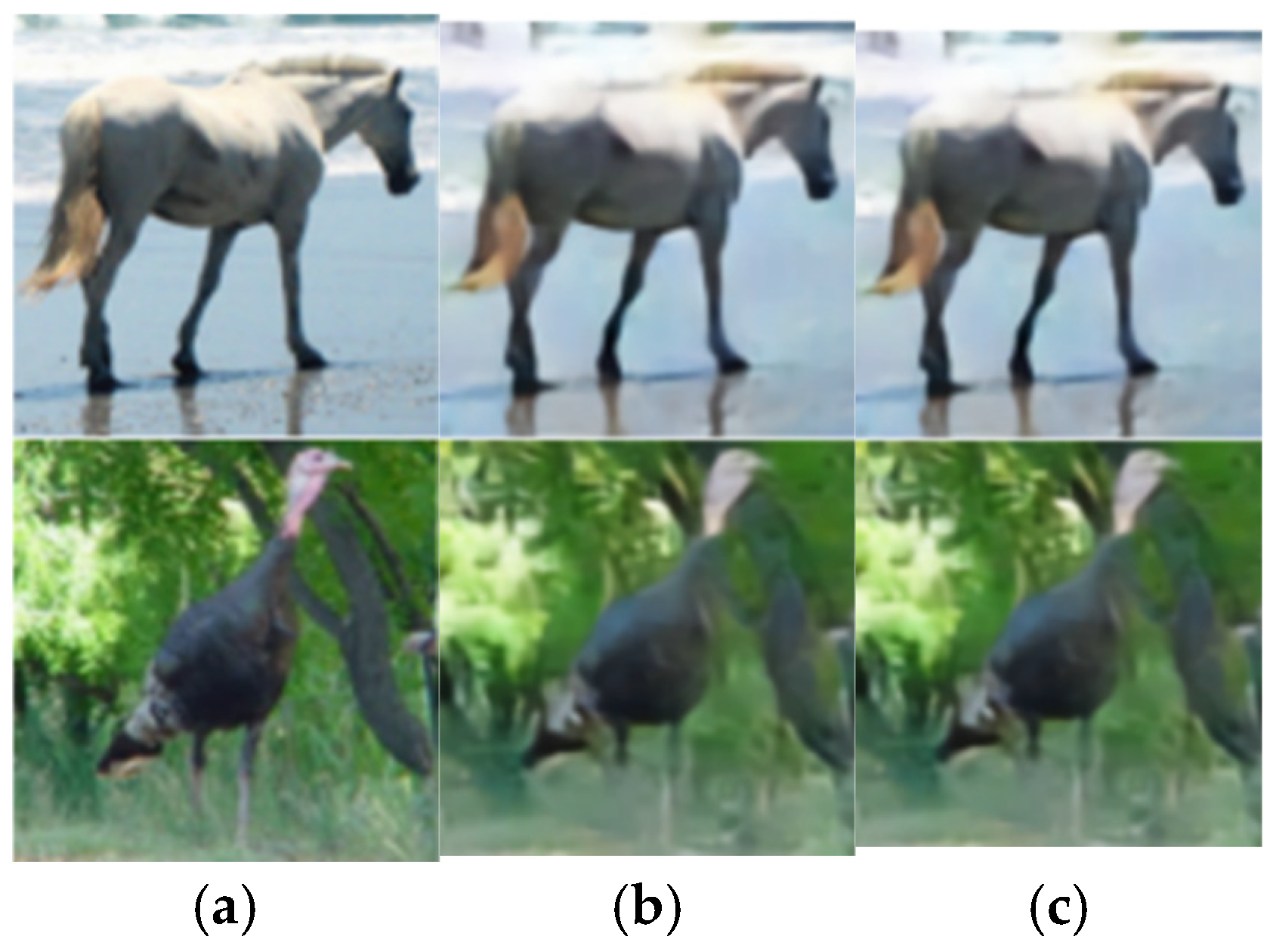
| One Round of Training Step | |
|---|---|
| Input: dataset of images to be reconstructed, Batch size , learning rate ; | |
| Output: SAC framework parameters ; | |
| 1: | Sample a batch of data from the dataset; |
| 2: | Perform the following operations on each data sample in ; |
| 3: | Randomly generate channel signal-to-noise ratio ; |
| 4: | Randomly generate compression ratio , ; |
| 5: | Input the image samples to be reconstructed into the encoder network to obtain the encoded semantic features ; |
| 6: | The semantic feature compression calculation is obtained through Equation (1); |
| 7: | Randomly generate physical channel noise based on SNR ; |
| 8: | Obtained through Equation (2); |
| 9: | Input the noised semantic features into the decoder network to obtain the reconstructed image ; |
| 10: | End the operation for each sample; |
| 11: | Calculate mean square error loss: |
| 12: | Update the module parameters . |
| Hardware/Dataset | Description |
|---|---|
| CPU | Intel® CoreTM i7-9700 |
| GPU | NVIDIA GeForce RTX 4060 Ti |
| Memory Capacity | 32 GB |
| GPU Driver Version | 535.146.02 |
| CUDA Version | 11.7 |
| Operating System | Ubuntu 18.04.6 LTS |
| Network | 1000 Mbps |
| Parameters | Values |
|---|---|
| Epochs (SAC) | 400 |
| Epochs (CE) | 150 |
| Batch Size | 128 |
| Optimizer | Adam |
| Learning Rate (LR) | 0.001 |
| Loss Function | MSE |
| SNR | [0, 27] dB |
| Compression Ratio (CR) | [0.05, 0.5] |
| Parameters | R = 1/3 (Compression Rate), SNR = 5 dB (Channel Condition) | |
|---|---|---|
| AWGN | Rayleigh | |
| Deep JSCC-V [18] | 23.7 dB | 22.5 dB |
| VAE-JSCC [32] | 22.1 dB | 10.4 dB |
| ADJSCC [25] | 24.8 dB | 20.2 dB |
| Diff-JSCC [33] | 22.0 dB | 19.7 dB |
| SGD-JSCC [34] | 23.5 dB | 19.0 dB |
| SAC Framework (ours) | 24.1 dB | 23.2 dB |
| Module | FLOPs | Parac | Memory |
|---|---|---|---|
| Deep JSCC-V [18] | 4.92 G | 63.79 M | 48.84 MB |
| SAC | 2.98 G | 38.51 M | 28.98 MB |
Disclaimer/Publisher’s Note: The statements, opinions and data contained in all publications are solely those of the individual author(s) and contributor(s) and not of MDPI and/or the editor(s). MDPI and/or the editor(s) disclaim responsibility for any injury to people or property resulting from any ideas, methods, instructions or products referred to in the content. |
© 2025 by the authors. Licensee MDPI, Basel, Switzerland. This article is an open access article distributed under the terms and conditions of the Creative Commons Attribution (CC BY) license (https://creativecommons.org/licenses/by/4.0/).
Share and Cite
Yang, H.; Wang, L.; Wang, P.; Li, J.; Qing, L.; He, X. Semantic Adaptive Communication Based on Double-Attention Phase and Compress Estimator for Wireless Image Transmission. Sensors 2025, 25, 7201. https://doi.org/10.3390/s25237201
Yang H, Wang L, Wang P, Li J, Qing L, He X. Semantic Adaptive Communication Based on Double-Attention Phase and Compress Estimator for Wireless Image Transmission. Sensors. 2025; 25(23):7201. https://doi.org/10.3390/s25237201
Chicago/Turabian StyleYang, Hong, Lijuan Wang, Pingyu Wang, Ji Li, Linbo Qing, and Xiaohai He. 2025. "Semantic Adaptive Communication Based on Double-Attention Phase and Compress Estimator for Wireless Image Transmission" Sensors 25, no. 23: 7201. https://doi.org/10.3390/s25237201
APA StyleYang, H., Wang, L., Wang, P., Li, J., Qing, L., & He, X. (2025). Semantic Adaptive Communication Based on Double-Attention Phase and Compress Estimator for Wireless Image Transmission. Sensors, 25(23), 7201. https://doi.org/10.3390/s25237201







